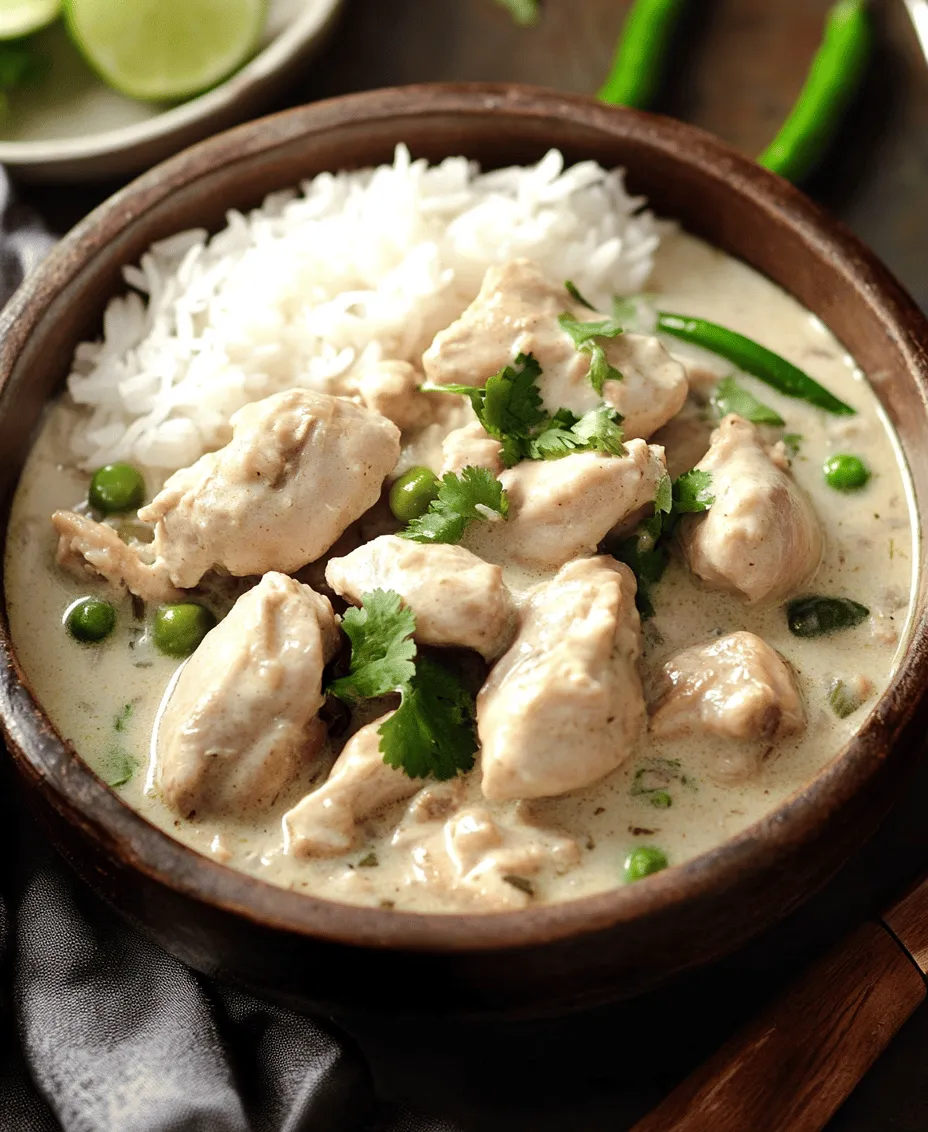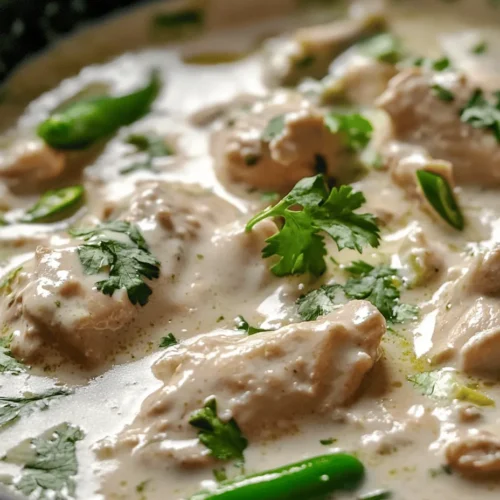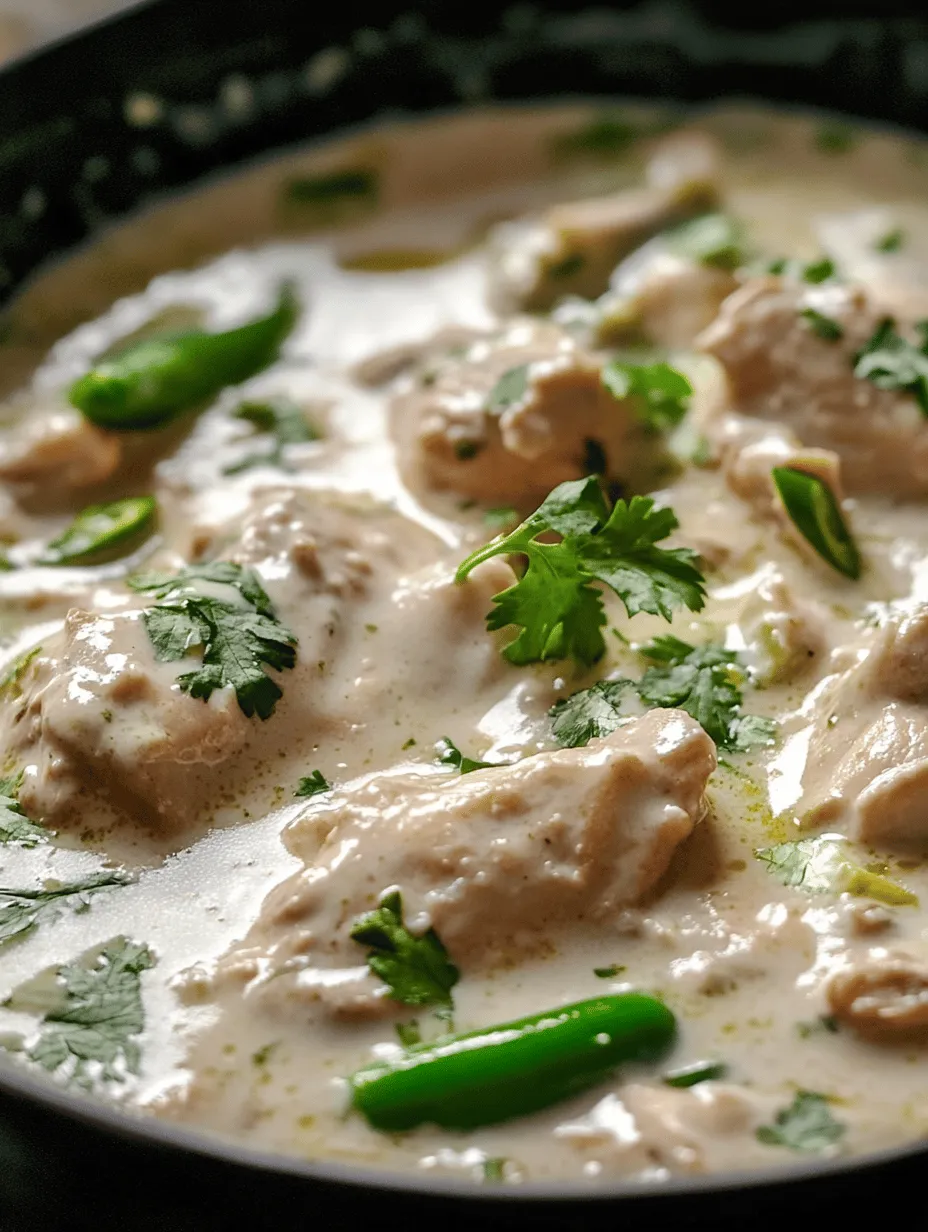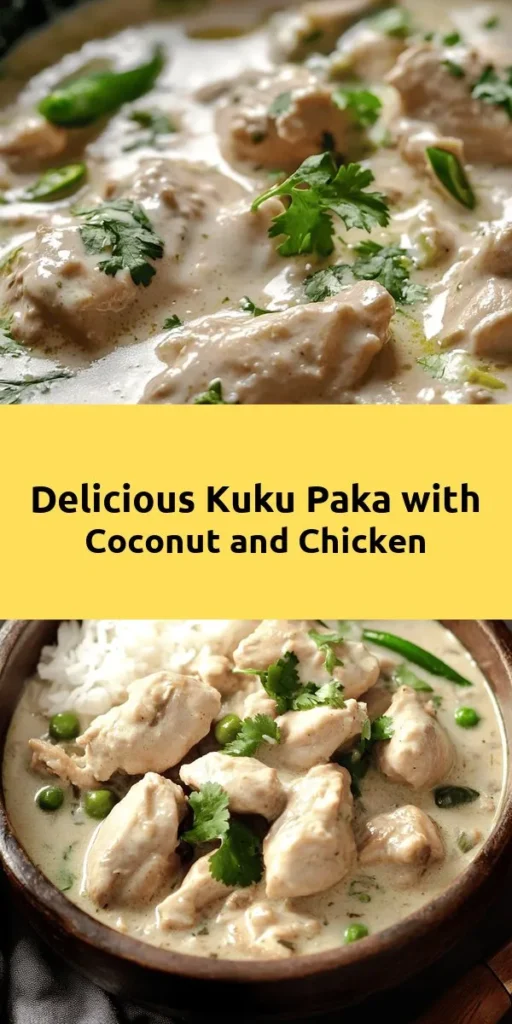Introduction
Kuku Paka is a dish that beautifully embodies the rich culinary tapestry of East Africa, particularly in coastal regions like Kenya and Tanzania. This delectable chicken curry is a delightful fusion of flavors, combining aromatic spices with the creamy goodness of coconut milk. Kuku Paka stands out not only for its taste but also for its cultural significance, often enjoyed during family gatherings, festivals, and special occasions. Whether you are a seasoned cook or a novice in the kitchen, this dish offers an accessible yet exotic experience that can easily become a favorite in your household.
The beauty of Kuku Paka lies in its adaptability. The combination of spices and coconut milk creates a comforting and warming dish that appeals to palates across the globe. Its universal appeal makes it an excellent choice for dinner parties or casual weeknight meals, inviting everyone to savor the unique flavors and textures. This dish not only satisfies hunger but also tells a story of cultural heritage and culinary innovation.
Understanding Kuku Paka
Origins of Kuku Paka
The roots of Kuku Paka can be traced back to the Swahili coastal cuisine, where the influence of various cultures—including Arab, Indian, and African—has shaped the culinary landscape. The term “Kuku” means chicken in Swahili, while “Paka” translates to “to coat” or “to smear,” referring to the method of cooking the chicken with a rich and flavorful sauce. Traditionally, Kuku Paka is prepared using fresh ingredients sourced from local markets, emphasizing the importance of quality and flavor in East African cooking.
As the dish has evolved, it has garnered various interpretations across different regions. Some versions may incorporate additional ingredients such as potatoes or vegetables, while others may feature different types of meat. Regardless of the variations, the essence of Kuku Paka remains the same—a celebration of flavor, culture, and community.
Variations of Kuku Paka
Kuku Paka has taken on many forms, each reflecting the unique culinary traditions of the region it hails from. In Kenya, the dish is often characterized by its use of coconut milk, which is readily available along the coast. In Tanzania, you might find it with a spicier profile, incorporating more chilies and different local spices. Additionally, some recipes include tamarind for a tangy twist, while others might feature a touch of peanut butter for added richness.
This adaptability allows home cooks to experiment and personalize the dish according to their taste preferences. Whether you lean towards a milder flavor or enjoy a spicier kick, Kuku Paka can be tailored to suit any palate, making it a versatile option for diverse dining experiences.
The Role of Coconut Milk in East African Cuisine
Coconut milk is a key ingredient in Kuku Paka, providing a creamy texture and a subtly sweet flavor that balances the spices. In East African cuisine, coconut milk is not just a culinary choice; it reflects the regions’ agricultural practices where coconuts are plentiful. The use of coconut milk in cooking dates back centuries, and it plays a significant role in many traditional dishes, enhancing both flavor and nutritional value.
Beyond its delightful taste, coconut milk is also a fantastic source of healthy fats and essential nutrients. It adds a distinct richness to the dish, creating a luxurious sauce that clings beautifully to the chicken. This ingredient is a testament to the region’s ability to create dishes that are both nourishing and satisfying, elevating humble ingredients into something extraordinary.
Ingredients Breakdown
To prepare Savory Kuku Paka Delight, you’ll need a selection of fresh and aromatic ingredients. Each component plays a crucial role in crafting the dish’s unique flavor profile.
Chicken
The foundation of Kuku Paka is undoubtedly the chicken. It is essential to choose bone-in, skinless pieces, as the bones contribute to a richer flavor during cooking. The skinless nature of the chicken allows the marinade and sauce to penetrate deeply, ensuring that every bite is infused with the dish’s signature taste. Thighs and drumsticks are particularly recommended for their tenderness and ability to remain juicy throughout the cooking process.
Coconut Milk
Coconut milk is the star of Kuku Paka, providing creaminess and a hint of sweetness that balances the heat from the spices. When selecting coconut milk, aim for a high-quality, full-fat variety to achieve the best flavor and texture. This ingredient not only enhances the dish’s richness but also adds a layer of complexity, making it an essential component of the recipe.
Onions, Garlic, and Ginger
The aromatic base of Kuku Paka is built upon the trio of onions, garlic, and ginger. Onions provide sweetness and depth, while garlic and ginger contribute bold, pungent flavors that elevate the dish. When sautéed together, they create a fragrant foundation that infuses the chicken and sauce with warmth and complexity. Using fresh ingredients is crucial, as they significantly impact the overall taste of the dish.
Spices
The spice blend is where Kuku Paka truly shines, showcasing a harmonious combination of flavors. Common spices include curry powder, turmeric, and coriander. Curry powder adds an earthy warmth, while turmeric provides a vibrant yellow hue and a slightly bitter note. Coriander brings a fresh, citrusy flavor that brightens the dish. The careful balance of these spices ensures a well-rounded taste that captures the essence of East African cuisine.
Green Chilies
For those who enjoy a bit of heat, green chilies are an essential addition. They can be adjusted according to your heat tolerance, making Kuku Paka customizable for everyone. Whether you prefer a mild flavor or a fiery kick, the choice of chilies allows you to tailor the dish to your liking.
Lemon Juice
Lemon juice serves a dual purpose in Kuku Paka. First, it acts as a natural tenderizer for the chicken during marination, ensuring that it remains juicy and flavorful. Second, the acidity from the lemon brightens the overall flavor, cutting through the richness of the coconut milk and balancing the dish.
Importance of Fresh Ingredients
Using fresh ingredients is paramount to achieving the best results in Kuku Paka. Fresh herbs, spices, and produce not only enhance the flavor but also contribute to the dish’s overall appeal. When possible, opt for locally sourced ingredients to ensure that the flavors are vibrant and authentic. The dedication to quality ingredients reflects the essence of East African cooking, where food is more than just sustenance—it’s a celebration of culture and community.
Preparation Steps
Now that we’ve explored the significance of each ingredient, it’s time to get into the preparation of Savory Kuku Paka Delight. The first and arguably most crucial step is marinating the chicken.
Marinating Chicken
Marinating the chicken is essential for developing robust flavors and ensuring tenderness. Begin by combining fresh lemon juice, garlic, ginger, and the selected spices in a bowl. This marinade not only imparts flavor but also helps to tenderize the chicken.
1. Prepare the Marinade: In a mixing bowl, combine the lemon juice, minced garlic, grated ginger, and your choice of spices, including curry powder, turmeric, and coriander. Add salt to taste and mix well.
2. Coat the Chicken: Place the chicken pieces into the marinade, ensuring they are entirely coated. Massage the marinade into the meat to maximize flavor absorption.
3. Marination Time: Ideally, allow the chicken to marinate for at least 30 minutes to an hour. For best results, marinate overnight in the refrigerator. This extended marination time allows the flavors to penetrate deeply, resulting in a more flavorful dish.
4. Prepare for Cooking: Once marinated, remove the chicken from the refrigerator and allow it to come to room temperature before cooking. This step helps ensure even cooking throughout.
As you prepare to move to the cooking phase, remember that the marination process is key to creating a Kuku Paka that bursts with flavor. Each step in the preparation contributes to the dish’s overall appeal, setting the stage for a delightful culinary experience.
With the chicken marinated and ready, you are well on your way to crafting a dish that not only tantalizes the taste buds but also invites those who gather around your table to share in the warmth and tradition of Kuku Paka.

Step-by-Step Guide to Sautéing Onions
Sautéing onions is a crucial step in preparing Savory Kuku Paka, as it forms the flavor base for the entire dish. Start by heating a generous amount of oil in a large skillet over medium heat. While the oil is heating up, finely chop two medium-sized onions. Once the oil is shimmering, add the chopped onions to the pan and stir to coat them evenly.
Cook the onions for about 5 to 7 minutes, stirring occasionally. The goal is to soften them and allow them to turn golden brown without burning. As the onions cook, they will release their natural sugars, enhancing the dish’s depth of flavor. If you notice the onions starting to stick to the pan or brown too quickly, reduce the heat slightly and add a splash of water to deglaze the pan. This will also help lift any browned bits from the bottom, adding even more flavor to your dish.
Tips for Achieving the Right Texture and Color
To achieve perfectly sautéed onions, patience is key. Here are a few tips to ensure your onions are just right:
1. Cut Evenly: Uniformly chopped onions will cook at the same rate, preventing some pieces from burning while others remain raw.
2. Temperature Control: Start with medium heat. If the onions brown too quickly, lower the heat to allow them to caramelize gently.
3. Add Salt Early: Sprinkle a pinch of salt over the onions as they cook; this helps draw out moisture, allowing the onions to soften more rapidly.
4. Color Indicators: Aim for a nice golden brown color, which indicates that the sugars have caramelized, adding sweetness and complexity to your Kuku Paka.
Cooking the Chicken: Techniques for Browning and Flavor Development
Once your onions are beautifully caramelized, it’s time to add the chicken. Ensure that your chicken pieces are bone-in and skin-on for the best flavor. Pat the chicken dry with paper towels to achieve a better sear. Season the chicken pieces generously with salt and black pepper.
Increase the heat to medium-high and add the chicken to the skillet. Allow the chicken to brown on all sides, which should take about 6 to 8 minutes. This step is crucial as it develops a rich, golden crust that enhances the overall flavor of the dish. Avoid overcrowding the pan; if necessary, brown the chicken in batches to ensure an even sear.
Once the chicken is browned, remove it from the skillet and set it aside. The fond left in the pan (the browned bits) will contribute to the sauce’s flavor when you add the coconut milk later.
Incorporating Coconut Milk: How It Transforms the Dish
Coconut milk is the star ingredient in Kuku Paka, giving it a creamy texture and a rich flavor profile. After browning the chicken, reduce the heat to medium and pour in one can (about 400ml) of coconut milk. Use a wooden spoon to scrape up the fond from the bottom of the pan, incorporating all those wonderful flavors into the sauce.
Stir the coconut milk gently to combine it with the sautéed onions and any remaining chicken juices. Allow the mixture to come to a gentle simmer before returning the browned chicken to the skillet. The coconut milk not only adds creaminess but also balances the spices and enhances the overall flavor profile, making each bite a delightful experience.
Simmering: Understanding the Cooking Process for Tenderness
Once the chicken pieces are back in the skillet, cover the pan and reduce the heat to low. Let the chicken simmer in the coconut milk for about 25 to 30 minutes. This slow cooking process allows the chicken to become tender and absorb all the flavors from the coconut milk and spices.
During this time, check occasionally to ensure the sauce isn’t boiling too vigorously. A gentle simmer is ideal for infusing flavors without drying out the chicken. If you find the sauce becoming too thick, you can add a splash of water or additional coconut milk to achieve your desired consistency.
Adjusting Seasoning: How to Taste and Tweak Flavors
As your Kuku Paka simmers, it’s essential to taste and adjust the seasoning. After about 20 minutes, sample the sauce to see if it needs more salt, pepper, or spices. Common spices used in Kuku Paka include turmeric, cumin, and coriander, which can be adjusted to suit your palate.
If you prefer a bit of heat, consider adding a chopped green chili or a dash of cayenne pepper at this stage. Remember that flavors will deepen as the dish cooks, so season judiciously. Allowing the dish to simmer for a bit after adjusting the seasoning will help meld the flavors together beautifully.
Serving Suggestions
Recommended Accompaniments: Why Rice or Chapati Works Best
Kuku Paka is traditionally served with fluffy white rice or chapati, a type of flatbread. The creamy coconut sauce pairs perfectly with both options, allowing you to soak up the delicious flavors. The rice provides a neutral base that balances the richness of the chicken, while chapati offers a delightful chewiness that complements the dish’s texture.
Presentation Ideas for an Appealing Dish
To make your Kuku Paka visually appealing, serve it in a large, shallow bowl. Garnish with fresh cilantro leaves and a sprinkle of red chili for a pop of color. You can also add a wedge of lime on the side to brighten the dish and offer a fresh zest when squeezed over the top.
Cultural Etiquette and Traditional Serving Methods
In East African culture, sharing food is a significant aspect of hospitality. When serving Kuku Paka, consider placing the dish in the center of the table, allowing everyone to help themselves. If you’re serving chapati, cut it into quarters and arrange it around the Kuku Paka for easy access. This communal style of dining encourages interaction and adds a warm, welcoming touch to your meal.
Nutritional Information
Overview of the Nutritional Benefits of Key Ingredients
Kuku Paka is not only delicious but also packed with nutritional benefits. The primary ingredients, chicken and coconut milk, offer a balance of protein and healthy fats. Chicken is a great source of lean protein, essential for muscle repair and overall health.
Coconut milk, while rich in calories, provides medium-chain triglycerides (MCTs) that may boost metabolism and support heart health. Onions add dietary fiber and antioxidants, while spices like turmeric and cumin come with anti-inflammatory properties.
Discussion on the Balance of Protein, Fats, and Carbohydrates in Kuku Paka
The balance of macronutrients in Kuku Paka makes it a wholesome meal. When served with rice or chapati, the dish provides complex carbohydrates that fuel energy levels. Together, the protein from the chicken, healthy fats from coconut milk, and carbohydrates from rice create a satisfying and nutritious meal.
Considerations for Dietary Restrictions and Modifications
For those with dietary restrictions, Kuku Paka can easily be adapted. For a vegetarian option, substitute the chicken with chickpeas or tofu. Ensure to use vegetable broth instead of chicken broth for added flavor. Additionally, for a dairy-free version, coconut milk is inherently dairy-free, making it an excellent choice for those with lactose intolerance.
Culinary Tips
Tips for Ensuring Perfectly Cooked Chicken Every Time
To guarantee juicy and tender chicken, consider these tips:
1. Brine the Chicken: Soaking the chicken in a simple brine of salt and water for a few hours prior to cooking can enhance moisture retention.
2. Use a Meat Thermometer: Ensure the internal temperature of the chicken reaches 165°F (75°C) for safe consumption.
3. Let It Rest: After cooking, allow the chicken to rest for a few minutes before serving. This helps redistribute the juices, resulting in a moister bite.
Suggestions for Ingredient Substitutions for Dietary Preferences
For a lighter version, you can use skinless chicken breasts instead of thighs. If you prefer a dairy alternative, you can replace coconut milk with almond milk, although this will change the flavor profile. For a gluten-free option, ensure that any additional condiments or sides are certified gluten-free.
How to Store Leftovers and Reheating Methods
If you have leftovers, Kuku Paka can be stored in an airtight container in the refrigerator for up to 3 days. To reheat, gently warm it on the stove over low heat, stirring occasionally. If the sauce thickens, add a splash of water or coconut milk. You can also microwave it, but be sure to cover it to prevent drying out.
Conclusion
Savory Kuku Paka is a delightful dish that showcases the vibrant flavors of East African cuisine. Its combination of tender chicken, creamy coconut milk, and aromatic spices creates a comforting meal that is sure to impress family and friends. This recipe not only highlights the rich culinary traditions of the region but also provides an opportunity to explore new flavors and cooking techniques.
Cooking is a joy, and sharing a meal like Kuku Paka can bring people together, fostering connections and creating lasting memories. So gather your loved ones, embrace the culinary journey, and enjoy the delightful experience of making and savoring Kuku Paka.



